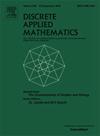Reliability analysis of godan graphs in terms of generalized 4-connectivity
IF 1
3区 数学
Q3 MATHEMATICS, APPLIED
引用次数: 0
Abstract
Let be a connected graph and . Denote by the maximum number of internally disjoint -trees , , , in such that and for any integers . For an integer with , the generalized -connectivity of a graph , denoted by , is defined as and . The generalized -connectivity of a graph is a natural extension of the classical connectivity and plays a key role in measuring the reliability of modern interconnection networks. The godan graph is a kind of Cayley graph which possess many desirable properties. In this paper, we study the generalized 4-connectivity of and show that , that is, there are internally disjoint -trees connecting any four vertices and in , where and .
基于广义4连通性的高丹图可靠性分析
设G为连通图,S⊥V(G)。用κG(S)表示G中使V(Ti)∩V(Tj)=S且E(Ti)∩E(Tj)=0的内部不相交S树T1, T2,…,Tr的最大个数r,对于任意整数1≤i<;j≤r。对于2≤k≤|V(G)|的整数k,定义图G的广义k-连通性为κk(G): κk(G)=min{κG(S)|S≤V(G), |S|=k}。图的广义k-连通性是经典连通性的自然扩展,在衡量现代互联网络的可靠性方面起着关键作用。高丹图EAn是一类具有许多理想性质的凯利图。本文研究了EAn的广义4-连通性,证明了κ4(EAn)=n−1,即存在n−1个内部不相交的S树连接EAn中的任意四个顶点x,y,z,w,其中n≥3且S={x,y,z,w}。
本文章由计算机程序翻译,如有差异,请以英文原文为准。
求助全文
约1分钟内获得全文
求助全文
来源期刊

Discrete Applied Mathematics
数学-应用数学
CiteScore
2.30
自引率
9.10%
发文量
422
审稿时长
4.5 months
期刊介绍:
The aim of Discrete Applied Mathematics is to bring together research papers in different areas of algorithmic and applicable discrete mathematics as well as applications of combinatorial mathematics to informatics and various areas of science and technology. Contributions presented to the journal can be research papers, short notes, surveys, and possibly research problems. The "Communications" section will be devoted to the fastest possible publication of recent research results that are checked and recommended for publication by a member of the Editorial Board. The journal will also publish a limited number of book announcements as well as proceedings of conferences. These proceedings will be fully refereed and adhere to the normal standards of the journal.
Potential authors are advised to view the journal and the open calls-for-papers of special issues before submitting their manuscripts. Only high-quality, original work that is within the scope of the journal or the targeted special issue will be considered.
 求助内容:
求助内容: 应助结果提醒方式:
应助结果提醒方式:


